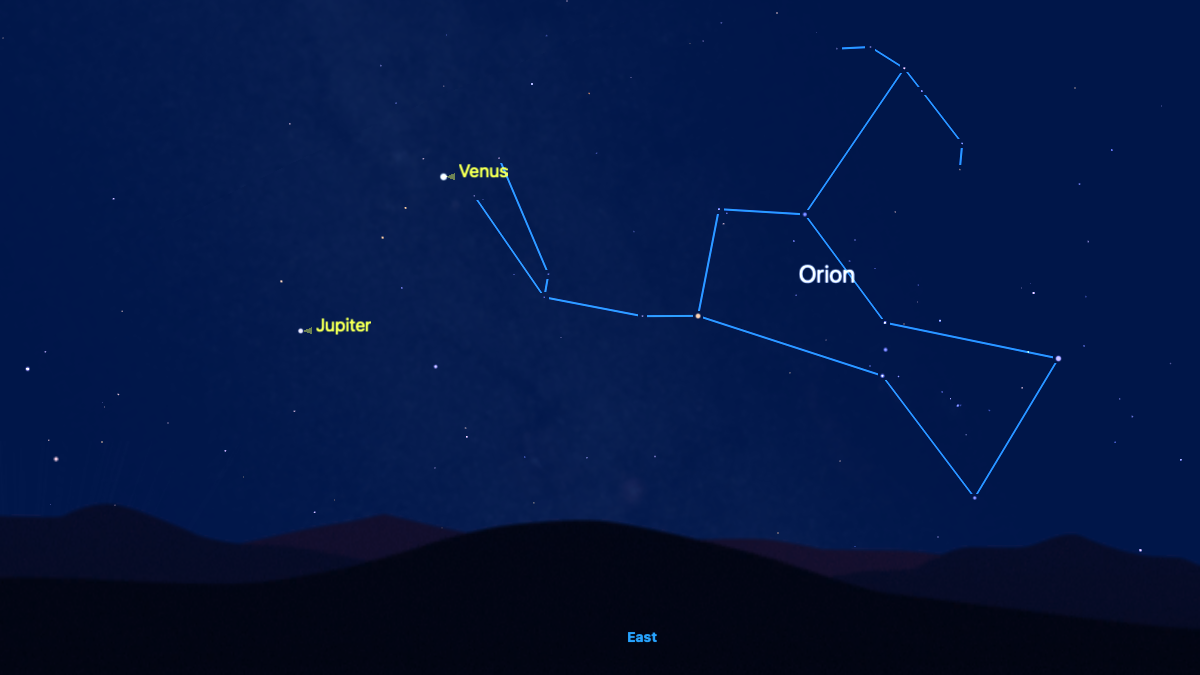Now Reading: Venus reaches its highest point in the eastern predawn sky on Aug. 1: Here’s how to see it
-
01
Venus reaches its highest point in the eastern predawn sky on Aug. 1: Here’s how to see it
Venus reaches its highest point in the eastern predawn sky on Aug. 1: Here’s how to see it

Venus will reach its highest altitude in the morning sky on Aug. 1 while shining close to Jupiter in the ‘hand’ of the constellation Orion.
Stargazers in the U.S. will see Venus rise above the eastern horizon around 3 a.m. local time close to the stars Chi Orionis and 64 Orionis, which represent the hand, or club of the great hunter from Greek mythology represented by the constellation Orion. The exact time that a planet rises and sets is dictated by your location, as is the altitude it will reach in the sky, so be sure to check a website like in-the-sky.org for specifics on your locale.
Venus will be at its highest in the 2025 predawn sky on Aug. 1, at which time it will appear as a bright ‘morning star’ to the naked eye; however, a telescope with an aperture of 2.4 inches or more will reveal the planet’s moon-like phases, according to telescope maker Celestron. For viewers in New York, Venus will reach an altitude of 31 degrees above the eastern horizon when the sun rises at 5:53 a.m. ET. Remember, the span of your clenched fist held at arms length accounts for roughly 10 degrees in the night sky.
The gas giant Jupiter will also be visible shining a little over 10 degrees to the lower left of Venus in the hours preceding dawn on Aug. 1, surrounded by the stars of the constellation Gemini, while Saturn will shine high above the southern horizon beneath Pisces. Stargazers new to locating constellations should read our roundup of the best astronomy smartphone apps available in 2025, which use augmented reality technology to help users pinpoint the locations of stars, galaxies and constellations in the night sky.

Venus’ path around the sun lies within the more distant orbit of Earth. As a result, the rocky world never strays far from the horizon compared to the ‘superior’ planets — Mars, Jupiter, Saturn, Neptune and Uranus — which orbit the sun beyond Earth, and so can appear high in the night sky depending on where they are in their cyclical journey.
The months following Aug. 1 will see the rocky world draw inexorably closer to the horizon with each passing morning, until its solar conjunction on Jan. 6, 2026, when it will pass close to the sun in the daytime sky, before transitioning to become an evening star.
Stargazers hoping to explore the phases of Venus and the night sky for themselves should read our roundup of the best telescopes for amateur astronomy in 2025. As always, extreme caution must be taken when observing an inferior planet to never point a telescope or binoculars near the rising or setting sun, as doing so can permanently damage your vision.
Stay Informed With the Latest & Most Important News
-
 012024 in Review: Highlights from NASA in Silicon Valley
012024 in Review: Highlights from NASA in Silicon Valley -
 02Panasonic Leica Summilux DG 15mm f/1.7 ASPH review
02Panasonic Leica Summilux DG 15mm f/1.7 ASPH review -
 03From Polymerization-Enabled Folding and Assembly to Chemical Evolution: Key Processes for Emergence of Functional Polymers in the Origin of Life
03From Polymerization-Enabled Folding and Assembly to Chemical Evolution: Key Processes for Emergence of Functional Polymers in the Origin of Life -
 04How New NASA, India Earth Satellite NISAR Will See Earth
04How New NASA, India Earth Satellite NISAR Will See Earth -
 05And Thus Begins A New Year For Life On Earth
05And Thus Begins A New Year For Life On Earth -
 06Astronomy Activation Ambassadors: A New Era
06Astronomy Activation Ambassadors: A New Era -
07SpaceX launch surge helps set new global launch record in 2024



















